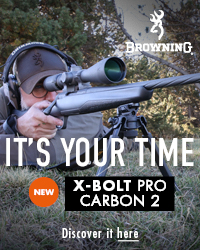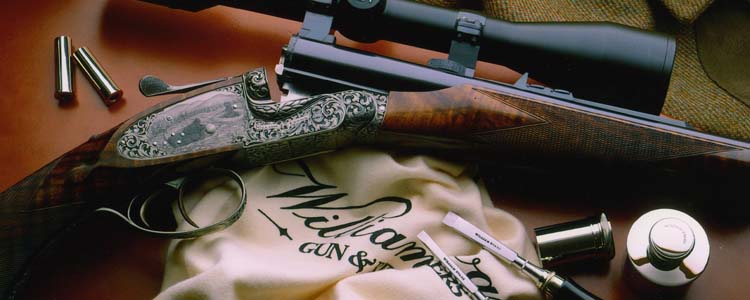Expanding Ammunition for Deer
Peter Jones discusses the use of expanding ammunition in deer management.
I have found that those new to deer stalking sometimes express surprise regarding the use and legality of expanding ammunition for deer stalking.
In fact expanding ammunition is not new to hunting and has been in use since as early as the 1870’s.
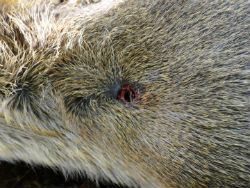 So what exactly is expanding ammunition? The firearms act defines it as: “a missile designed or adapted to expand on impact” Most bullets, given sufficient energy will in fact expand on impact, and so the key phrase here is ‘Designed or adapted’. Expanding bullets will typically take the form of ‘Soft nose’, ‘hollow point’ and ‘Ballistic tip’ and have in the past also been referred to as ‘dumdums’ or ‘dum dum bullets’.
So what exactly is expanding ammunition? The firearms act defines it as: “a missile designed or adapted to expand on impact” Most bullets, given sufficient energy will in fact expand on impact, and so the key phrase here is ‘Designed or adapted’. Expanding bullets will typically take the form of ‘Soft nose’, ‘hollow point’ and ‘Ballistic tip’ and have in the past also been referred to as ‘dumdums’ or ‘dum dum bullets’.
(Fig 1: Above: Entry wound .308 Winchester 150 grain Federal soft point expanding ammunition)
In order to understand the legality and use of expanding ammunition, it helps to look a little at its evolution. In the past early bullets were in fact solid, round and made of a soft metal such as lead. These soft metal projectiles would often deform and expand on impact and cause a much larger wound than otherwise might be the case had the bullet retained its original diameter and form.
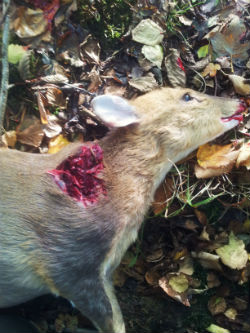 With the introduction of ‘rifling’ and longer thinner bullets, the soft metal core was protected by a hard coating known as a ‘full metal jacket’. The aim of this was initially in order to protect the barrel from excessive fouling.
With the introduction of ‘rifling’ and longer thinner bullets, the soft metal core was protected by a hard coating known as a ‘full metal jacket’. The aim of this was initially in order to protect the barrel from excessive fouling.
(Fig 2: Exit wound; .308 Winchester 150 grain Federal soft point expanding ammunition, illustrating the huge expansion even on a small deer such as Muntjac)
It was noticed however that a by product of this was that the wound inflicted by the bullet was reduced. Realising this it was the British Army who went on to create expanding ammunition by removing the jacket from the nose of the bullet, thereby creating the first ‘soft nose bullet’.
After much protestation about the wounds inflicted by such ammunition by other European countries, the Hague Convention 1899 outlawed their use in circumstances of war. This was despite a gallant and notable effort made by Sir John Ardagh who put the case in a rather amusing and typically colonial way for the continued use of expanding ammunition in warfare.
"The civilized soldier when shot recognizes that he is wounded and knows that the sooner he is attended to the sooner he will recover. He lies down on his stretcher and is taken off the field to his ambulance, where he is dressed or bandaged. Your fanatical barbarian, similarly wounded, continues to rush on, spear or sword in hand; and before you have the time to represent to him that his conduct is in flagrant violation of the understanding relative to the proper course for the wounded man to follow—he may have cut off your head”.
Brilliantly put! However the motion was carried 22-2 and expanding ammunition or ‘Dumdums’ were outlawed.
It is crucial to note however that the convention only outlawed the use of dum dum bullets in war. Their use was not outlawed for use by the police or in hunting. This is why we are in effect allowed to use this type of ammunition today in deer management.
If we look at: ‘Firearms Law - Guidance to the Police’ which is issued via the Home Office to all Police Forces we read the following:
Expanding Ammunition is prohibited under: section 5(1A)(f) of the 1968 Act now prohibits any ammunition which incorporates a missile designed or adapted to expand on impact and section 5(1A)(g) prohibits the bullets for such ammunition (expanding missiles, in the words of the Act).
However read on and we see the exemption:
Exemptions
4.4 Section 10 of the 1997 Act amended section 5A(4) of the 1968 Act to exempt from the general prohibition on expanding ammunition people who use it for specific purposes. The exemptions cover those people who use expanding ammunition for the:
1. lawful shooting of deer;
2. shooting of vermin or, in the course of estate management, other wildlife;
3. humane killing of animals; and
4. shooting animals for the protection of other animals or humans.
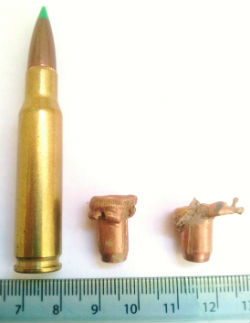 And rightly so! The use of expanding ammunition has played an important part in the humane dispatch of deer. A deer shot with a text book heart/lung shot will usually expire as a result of blood loss. Put simply the ‘mushrooming’ effect created by an expanding bullet increases the diameter of the bullet path and thereby enhances the width of the wound channel into which blood is lost.
And rightly so! The use of expanding ammunition has played an important part in the humane dispatch of deer. A deer shot with a text book heart/lung shot will usually expire as a result of blood loss. Put simply the ‘mushrooming’ effect created by an expanding bullet increases the diameter of the bullet path and thereby enhances the width of the wound channel into which blood is lost.
(Fig 3: Illustrating a .308 calibre ballistic tip, expanding bullet after impact. Notice the far right bullet has expanded from 7.62mm to over 15mm in diameter)
Not only this, but expanding projectiles are also capable of increasing the rate at which kinetic energy is transferred to the animal, this can be attributed to why some Deer will be seen to simply drop to the shot rather than bleed out.
In the course of my job as a professional deer manager I have witnessed the reaction of numerous deer to being shot. Whilst all of these shots have of course been taken with expanding ammunition, as the law requires, I do recall incidents when the bullet, perhaps as a result of a manufacturing fault, has not properly expanded.
I recall one such incident involving a very light weight yearling Roe Doe. To my surprsie the animal having been shot with a .308, 150 grain ballistic tip bullet at just 25 yards made a determined dash of some 70 yards before collapsing.
Examination of the wound revealed a typically small entry wound, but also a surprisingly small exit wound. Further examination revealed a neat, small diameter wound channel through the heart and lungs, thereby exhibiting the type of injury that might typically be sustained by a ‘full metal jacket’ bullet and more than likely the reason why it had taken this slight framed animal longer to expire than otherwise might be expected.
Proof enough for me that the use of expanding ammunition is crucial in not only bringing about a prompt and humane death but also in the recovery of shot animals.
To read more about 'Expanding ammunition' and the use of 'Ballistic tips' Click on this link: ballistic-tips-accuracy-v-carcass-damage
For more on Rifle Calibres Click on the following: rifle-calibres



